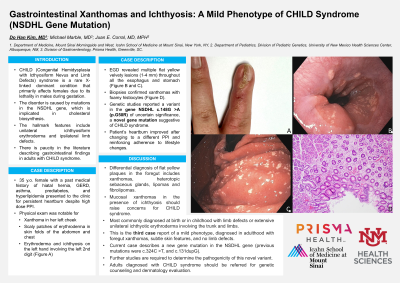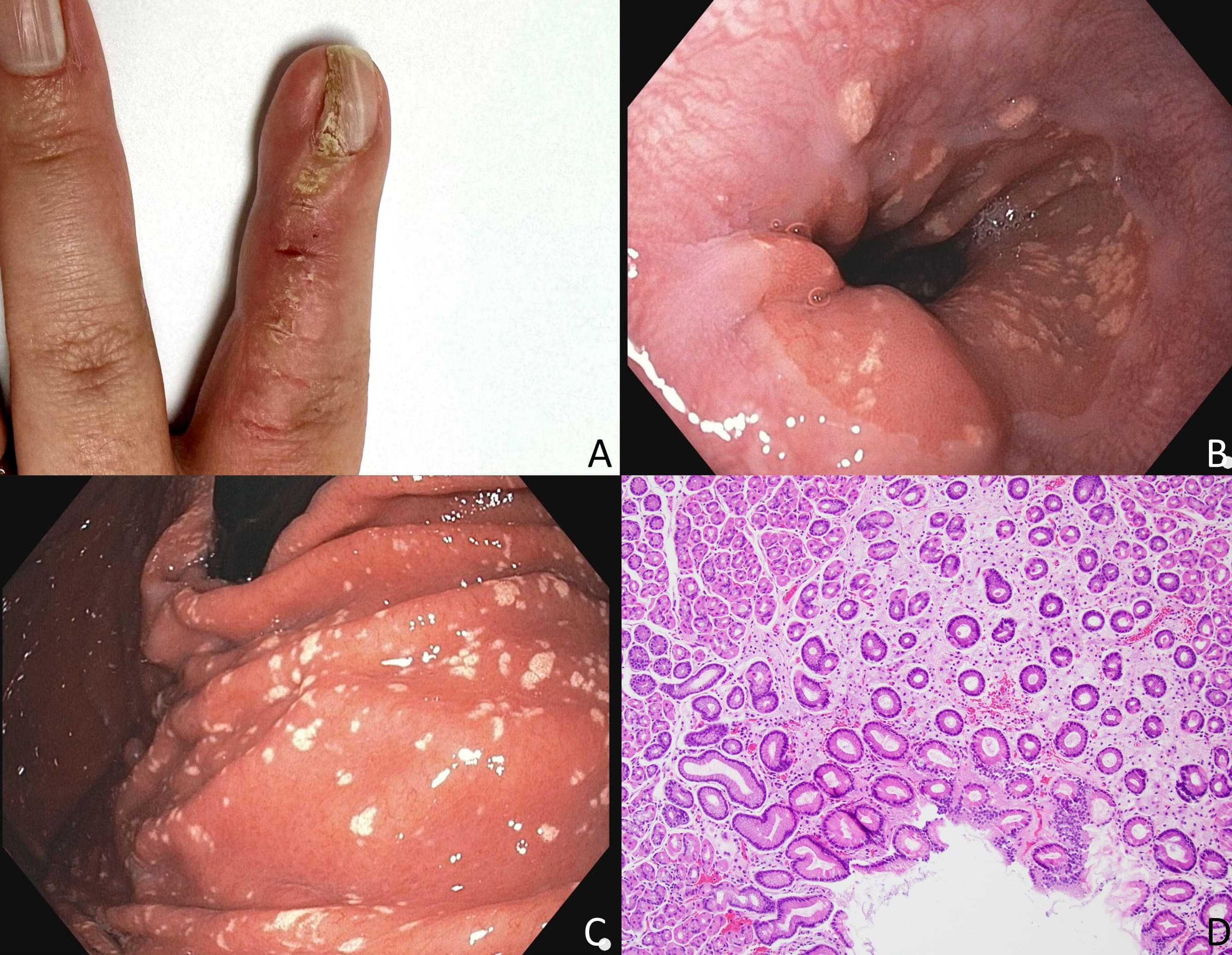Sunday Poster Session
Category: General Endoscopy
P0702 - Gastrointestinal Xanthomas and Ichthyosis: A Mild Phenotype of CHILD Syndrome (NSDHL Gene Mutation)
Sunday, October 27, 2024
3:30 PM - 7:00 PM ET
Location: Exhibit Hall E

Has Audio
- DK
Do Han Kim, MD, MSc
Mount Sinai Morningside & West, Icahn School of Medicine at Mount Sinai
New York, NY
Presenting Author(s)
Do Han Kim, MD, MSc1, Michael Marble, MD2, Juan E. Corral, MD3
1Mount Sinai Morningside & West, Icahn School of Medicine at Mount Sinai, New York, NY; 2University of New Mexico Health Sciences Center, Albuquerque, NM; 3Prisma Health, Greenville, SC
Introduction: CHILD (Congenital Hemidysplasia with Icthyosiform Nevus and Limb Defects) syndrome is a rare X-linked dominant condition that primarily affects females due to its lethality in males during gestation. The disorder is caused by mutations in the NSDHL gene, which is implicated in cholesterol biosynthesis. The hallmark features include unilateral ichthyosiform erythroderma and ipsilateral limb defects. There is paucity in the literature describing gastrointestinal findings in adults with CHILD syndrome.
Case Description/Methods: 35-year-old female with a past medical history of hiatal hernia, gastroesophageal reflux disease, asthma, prediabetes, and hyperlipidemia presented to the clinic for persistent heartburn despite high dose proton pump inhibitors. Physical exam was notable for xanthoma in her left cheek, scaly patches of erythroderma in skin folds of the abdomen and chest, and erythroderma and ichthyosis on the left hand involving the left 2nd digit (Figure 1).
Esophagogastroduodenoscopy (EGD) revealed multiple flat yellow velvety lesions (1-4 mm) throughout all the esophagus and stomach (Figure 2). Biopsies confirmed xanthomas with foamy histiocytes (Figure 3). Genetic studies reported a variant in the gene NSDHL c.148G >A (p.G50R) of uncertain significance, a novel gene mutation suggestive of CHILD syndrome.
Patient’s heartburn improved after changing to a different PPI and reinforcing adherence to lifestyle changes.
Discussion: Differential diagnosis of flat yellow plaques in the foregut includes xanthomas, heterotopic sebaceous glands, lipomas and fibrolipomas (the latter two being typically polypoid). Mucosal xanthomas in the presence of ichthyosis should raise concerns for CHILD syndrome. Most patients with CHILD syndrome are diagnosed at birth or in childhood with limb defects or extensive unilateral ichthyotic erythroderma involving the trunk and limbs. This is the third case report of a mild phenotype, diagnosed in adulthood with foregut xanthomas, subtle skin features and no limb defects. Current case describes a new gene mutation in the NSDHL gene (previous mutations were c.324C >T, and c.131dupG). Further studies are required to determine the pathogenicity of this novel variant. Adults diagnosed with CHILD syndrome should be referred for genetic counseling and dermatology evaluation.

Disclosures:
Do Han Kim, MD, MSc1, Michael Marble, MD2, Juan E. Corral, MD3. P0702 - Gastrointestinal Xanthomas and Ichthyosis: A Mild Phenotype of CHILD Syndrome (NSDHL Gene Mutation), ACG 2024 Annual Scientific Meeting Abstracts. Philadelphia, PA: American College of Gastroenterology.
1Mount Sinai Morningside & West, Icahn School of Medicine at Mount Sinai, New York, NY; 2University of New Mexico Health Sciences Center, Albuquerque, NM; 3Prisma Health, Greenville, SC
Introduction: CHILD (Congenital Hemidysplasia with Icthyosiform Nevus and Limb Defects) syndrome is a rare X-linked dominant condition that primarily affects females due to its lethality in males during gestation. The disorder is caused by mutations in the NSDHL gene, which is implicated in cholesterol biosynthesis. The hallmark features include unilateral ichthyosiform erythroderma and ipsilateral limb defects. There is paucity in the literature describing gastrointestinal findings in adults with CHILD syndrome.
Case Description/Methods: 35-year-old female with a past medical history of hiatal hernia, gastroesophageal reflux disease, asthma, prediabetes, and hyperlipidemia presented to the clinic for persistent heartburn despite high dose proton pump inhibitors. Physical exam was notable for xanthoma in her left cheek, scaly patches of erythroderma in skin folds of the abdomen and chest, and erythroderma and ichthyosis on the left hand involving the left 2nd digit (Figure 1).
Esophagogastroduodenoscopy (EGD) revealed multiple flat yellow velvety lesions (1-4 mm) throughout all the esophagus and stomach (Figure 2). Biopsies confirmed xanthomas with foamy histiocytes (Figure 3). Genetic studies reported a variant in the gene NSDHL c.148G >A (p.G50R) of uncertain significance, a novel gene mutation suggestive of CHILD syndrome.
Patient’s heartburn improved after changing to a different PPI and reinforcing adherence to lifestyle changes.
Discussion: Differential diagnosis of flat yellow plaques in the foregut includes xanthomas, heterotopic sebaceous glands, lipomas and fibrolipomas (the latter two being typically polypoid). Mucosal xanthomas in the presence of ichthyosis should raise concerns for CHILD syndrome. Most patients with CHILD syndrome are diagnosed at birth or in childhood with limb defects or extensive unilateral ichthyotic erythroderma involving the trunk and limbs. This is the third case report of a mild phenotype, diagnosed in adulthood with foregut xanthomas, subtle skin features and no limb defects. Current case describes a new gene mutation in the NSDHL gene (previous mutations were c.324C >T, and c.131dupG). Further studies are required to determine the pathogenicity of this novel variant. Adults diagnosed with CHILD syndrome should be referred for genetic counseling and dermatology evaluation.

Figure: A. Dysplastic nail and ichthyosis, B. Multiple flat yellow lesions in gastroesophageal junction, C. Multiple flat yellow lesions in gastric cardia, D. Biopsy with foamy histiocytes confirming xanthomas
Disclosures:
Do Han Kim indicated no relevant financial relationships.
Michael Marble indicated no relevant financial relationships.
Juan Corral indicated no relevant financial relationships.
Do Han Kim, MD, MSc1, Michael Marble, MD2, Juan E. Corral, MD3. P0702 - Gastrointestinal Xanthomas and Ichthyosis: A Mild Phenotype of CHILD Syndrome (NSDHL Gene Mutation), ACG 2024 Annual Scientific Meeting Abstracts. Philadelphia, PA: American College of Gastroenterology.
